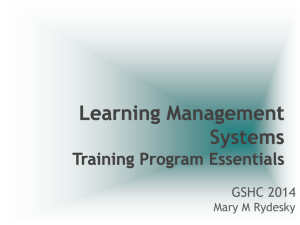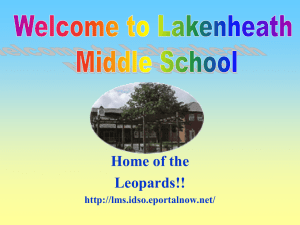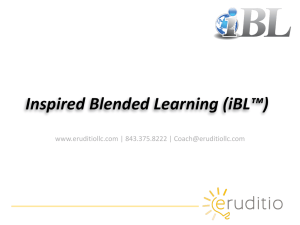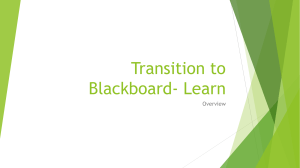Administration Tools
advertisement
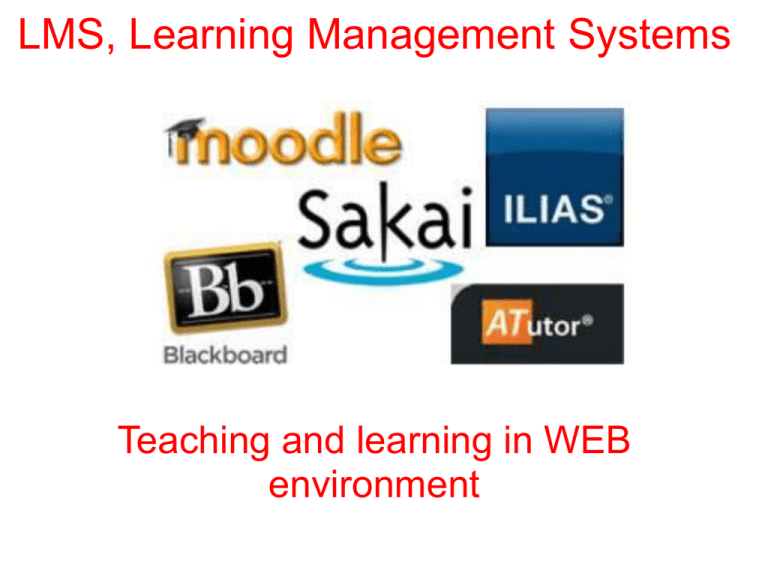
LMS, Learning Management Systems Teaching and learning in WEB environment Definition of Learning Management Systems LMS Either for e-learning or in addition to in-classroom courses Enables to plan and track learning processes Provides courses, books, training events and other content Has the ability to register learners for courses Platforms for learning • In most cases, web based integrated information systems • Support the online activities of the persons involved in teaching and learning. • Facilitate the administration of and access to learning content anytime, anywhere and with any pace. Types of LMS LMS Platforms Open source Commercial • • • • • • • • • • • • • • • • • • • • • • • • ATutor Bazaar Bodington DoceboLMS Dokeos e-Learning XHTML Editor Fle3 GaneshaLMS ILIAS interact KEWL.Nextgen LRN Moodle OLAT Mitechsoft Sakai ANGEL Learning Apex Learning Blackboard Inc. Desire2Learn eCollege Learn.com Meridian KSI Saba Software SAP Enterprise Learning WebCT, 12 Best Free Learning Management Systems (LMS) Top 20 Learning Management Systems for 2013/20134 Characteristics of learning platforms • • • • • Presentation of learning content Creation of assignments Support the assessment Administration Communication Some concepts • Learning platform • Learning portal • Content Management Systems… • Learning Management Systems… • Personalised Learning Environments… Learning management systems, in particular open-source, play a key role in bridging the digital divide. Educational institutions must integrate them to their websites, portals, catalogs of libraries, learning repositories, etc.. Portal SIO The differences between CMS, LMS and LCMS • Learning Management Systems (LMS) – Administration and supervision of learning process – Tracking – Communication • Content Management Systems (CMS) – – – – Creation and administration of contents Presentation and publishing Exchange of contents Examples: Joomla, WordPress • Learning Content Management Systems (LCMS) – Integration of LMS and CMS – Standards for e-learning (IMS, SCORM) – Example: ILIAS C3MS • Content, community and collaboration management systems (C3MS) • C3MSs are effective learning tools to support socio-constructivist approaches such as project-based learning in virtual learning environments. • The teacher is the manager, moderator and facilitator. WEB Why we need LMS? • Complete or partial replacement of frontal teaching. • Management of students, track their progress through all educational activities. • Management of courses (subjects) and the exchange of information with students. Management Reports to Evaluate Learning Performance • Helps provide usage and cost information for managers to accurately assess return on investment of training activities. • Enables full tracking of learning resources and performance using a range of standard reports • Provides detailed reporting to individual, which can provide valuable information on training and assessments. 10 features that a LMS should have • Can the LMS be implemented quickly and easily, without programming? • Does the LMS system have a robust feature set, or is it really just a collection of documents for online viewing? • Can the LMS support multimedia files such as Flash, streaming video, movies, and audio narrations? • Is the LMS truly a web native solution, using open standards like HTML, SQL, and HTTP? • Does the new LMS have everything you need built in, or will you need to buy an external authoring or reporting tool? • Is the LMS product widely accepted in a variety of industries, or is it a limited niche product? • Does the selected LMS support instructor-led training and self-paced automated training, as well as classroom (off-system) training? • Can the LMS easily support Skill Groups or certifications, so you can track learners' progress toward defined goals? • Can the LMS seamlessly pull together learning content from various sources and formats? • Does the LMS come with actual source code, in case you need to make modifications later? LMS features • Learner Tools – Communication Tools • • • • • • • Discussion Forums File Exchange Internal Email Online Journal/Notes Real-time Chat Video Services Whiteboard – Productivity Tools • • • • • Bookmarks Orientation/Help Searching Within Course Calendar/Progress Review Work Offline/Synchronize – Student Involvement Tools • • • • Groupwork Self-assessment Student Community Building Student Portfolios Source: http://www.edutools.info/compare.jsp?pj=8&i=263,276,299,358,366,386,387 LMS features • Support Tools – Administration Tools • • • • Authentication Course Authorization Registration Integration Hosted Services – Course Delivery Tools • • • • • Course Management Instructor Helpdesk Online Grading Tools Student Tracking Automated Testing and Scoring – Curriculum Design • • • • • • • Accessibility Compliance Course Templates Curriculum Management Customized Look and Feel Instructional Standards Compliance Instructional Design Tools Content Sharing/Reuse Comparison: http://www.edutools.info/compare.jsp?pj=8&i=276,358,392 Technical requirements • • • • • • • • Data Management : Usually a relational database modularisation scalability distribution integration Using Web services to integrate the LMS with user databases Server-side scripts Compliance with standards – web standards – accessibility standards – Standards of e-learning Standards, related to LMS • IMS Global – non-profit standards organization – concerned with establishing interoperability for learning systems and learning content – mission is to "support the adoption and use of learning technology worldwide". • SCORM – Sharable Content Object Reference Model – A collection of standards and specifications for web-based e-learning – Defines communications between client side content and a host system called the run-time environment – Also defines how content may be packaged into a transferrable ZIP file. • eLML – The eLesson Markup Language (eLML) – Is an open source XML framework for creating eLessons using XML – The didactical fundament of eLML is the pedagogical model called ECLASS LMS provides collaboration tools • Forums, chat rooms, e-mail notifications, which used both pupils and teachers and administration • Allows blended learning • Encourages learners to access to learning materials only and manage their learning according to their needs. • Sharing applications Domains of application • classical schools • Centers for distance education • Internal training centers of companies • Schools for students with special needs • In Moodle a teacher has full control over all settings for a course, choice of course formats such as by week, by topic or a discussionfocussed social format, course themes, • Facilitates forums, quizzes, glossaries, resources, surveys, assignments, chats, workshops. • • • • Students can be divided into groups Access to data on pupils Is scalable up to 10,000 more pupils per institution Probably the most widely used LMS Moodle philosophy – constructivism – social constructivism – connected or separate Moodle disadvantages Some are not a problem with Moodle but of education or all LMSs as a whole: • Social networking: capacity for forming learner groups and friendship groups informally. Most learning happens informally. • Exchange of content: It is difficult to share activities and content between teachers. • Ease of use: some parts of Moodle are very easy to use and some are very hard to use. • Viewing, sharing, commenting on student projects: not so easy. It is easier to do forum discussions or quizzes. • Face-to-face learning: the physical classroom and its tasks need more integration with an LMS. Moodle Sindrom People choose open source solutions, including Moodle often. The reasons are as follows: • it's free • We assume that this tool is a "turnkey" and immediately ready • That is designed for our needs Moodle is an important player and offers its users a variety of additional packages. We choose what we want Claroline • Allows teacher to write a course description, publish documents in any format, administer public and private forums, develop learning paths, create groups of students, prepare online exercises, publish announcements • built over pedagogical principles • allowing a large variety of pedagogical setup including widening of traditional classroom and online collaborative learning • Translated into 35 languages. DEMO Learning model of Claroline OLAT - The Open Source LMS • A well featured system in its tenth year of development. Recently the winner of the “IMS Learning Impact ‘Leadership Award’ 2009 for best open source learning platform”. • Multilingual online translation tool having flexible course system. • Offers wikis, single pages with integrated WYSIWYG HTML editor, forums and "file dialog" element to discuss papers, questionnaire for course evaluations, etc. EFront • Offers a wide range of features from content creation, test builder, project management, extended statistics, internal messaging system, forum, chat, surveys User management • Lessons, Courses and Categories management, Files management, Exam builders, Assignments builders, Communication tools (Forum, Chat, Calendar, Glossary), Progress tracking, Authentication methods, Enrollment methods, Certifications, Reports generators, Modules management, Payment integration and more. eFront Fle3 > Future Learning Environment Supports learner and group centered work that concentrates on creating and developing expressions of knowledge. Easy to localize to different languages. Fle3 WebTops can be used by teachers and students to store different items, organize them to folders and share them with others. Written in Python ATutor Actually an LCMS, ATutor also offers tools for the management of learning. The “A” stands for Accessible and it has excellent support for key accessibility standards as well as support for SCORM, IMS etc. WEB DEMO ILIAS • Try out: http://143.50.63.94/ilias3 – administrator: • usern: citel • pw: tel123 – user: • usern: test • pw: test123 Problems with LMS: Features First..Usability Second (1) • Feature sets and enhancements are necessary for the evolution of any system and mandatory to garner more market share. • There are plenty of vendors out there who believe in the concept of focusing on features and forgetting about usability, under the guise that people would rather have lots of cool blinky things rather than usability • People want new and cool features, but they won’t utilize it, if your usability is difficult or challenging. Focus first on usability and everything else while come into place Problems with LMS: Features First..Usability Second (2) • Some common traits include: – Broadway Effect: Front end looks too busy, end users cannot figure out what to click, where to go, what to avoid – lots of information, flashiness, overload of the senses – Illogical – I often see systems that add features that seem as though they tossed a bunch of ideas on a wall and whatever stuck up there, went into their platform – Miss Targeted – A frequent guest, whereas they add features or enhancements that do not target their current customer base or future -example: they include corporate yet include rubrics – The True Wizard of Oz – Systems forget that the true power comes from the administrator side and thus the importance of usability should be their top goal, not some add-on that people may want LMS comparison WEB Issues (1) • Evaluation of LMS? – Does LMS help students, faculty, staff? – Content, interaction, assessment .. • Integrate with existing systems? – Registration, course catalog, grade databases, content servers • Integrate with e-commerce? – Textbook publishers, digital libraries … • Standards compatibility? – Exchange content and learner info between LMS Issues (2) • Management/technical issues – Who manages LMS? Platform, cost, technical competency required ... • Faculty and student development – Training, curriculum development, support • Security issues – Implications for access, testing ... • Policy issues – Policies for grades, credits, class lists, privacy E-learning Standards • Share content (‘learning objects’) across LMS • Share learner information across LMS • Requires standard descriptions and interoperability specifications • How to describe learning objects? • How to describe learners? • ====> metadata Personalised learning networks … Integrated learning networks… WEB 2.0 Personalised Learning Student Choice Connect Learners Evidence How to survive a personalized learning? Overload… ‘e-portfolio concept Education Viewsi Files Views of eportfolio … eportfolio-polytechnic.net.au Different LMS – distributed content • Content packages imported in multiple LMS. • Contents duplicated on multiple systems. • LMS contains: contents, access control, data about students. • Difficult management of content‘s lifecycle New model, centralized content • The content is considered as service • Content is gosted on content servers • LMSs can address a valid content. • Service interfaces control data about students and access to the contents Services in cloud LMS in cloud This should resolve problems with backups, minimal downtime time, solving of failures, warnings, scalability and other difficult tasks. When LMS in cloud makes sense? LMS in cloud examples WEB WEB

